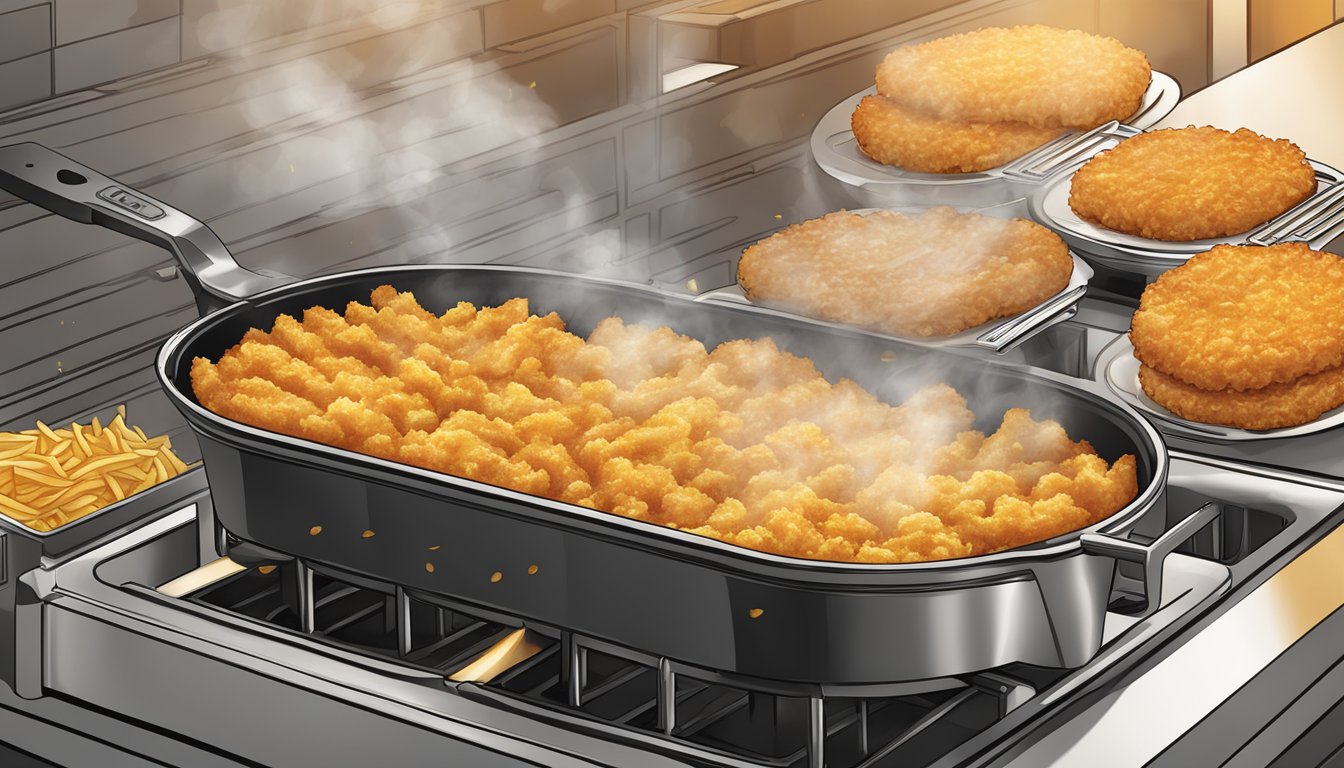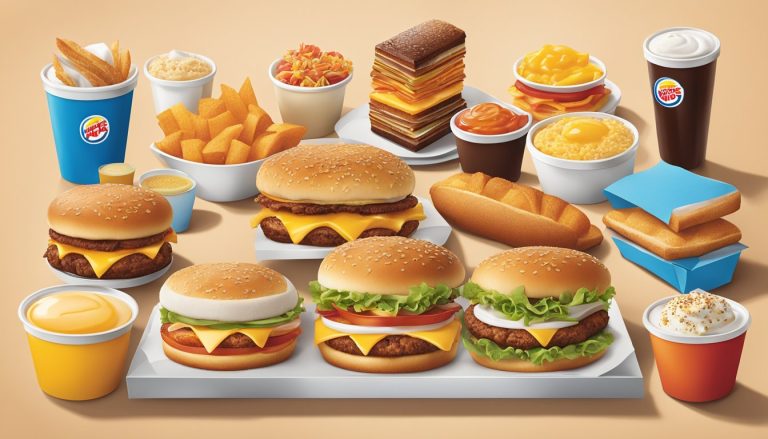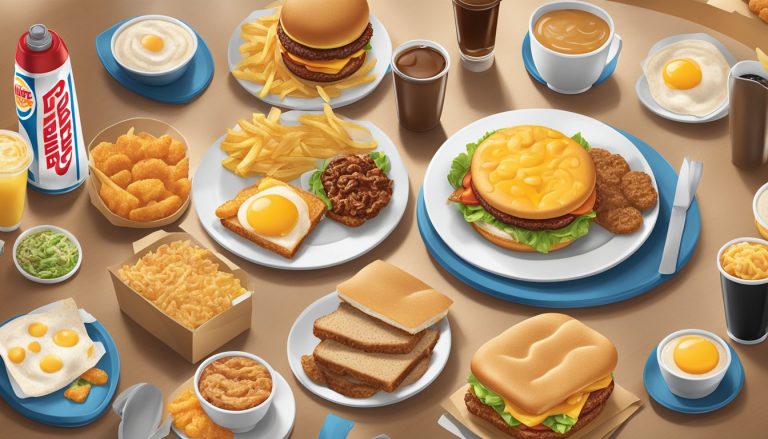Burger King’s hash browns have become a beloved breakfast staple for fast food enthusiasts. These golden, crispy potato discs offer a satisfying crunch and savory flavor that keeps customers coming back for more. Burger King offers three sizes of hash browns – small, medium, and large – with prices ranging from $2.49 to $4.67.
Available only during breakfast hours from 6:00 a.m. to 10:30 a.m., these hash browns are the perfect accompaniment to any morning meal. Their simplicity belies the careful preparation that goes into creating the ideal texture and taste. Shredded potatoes are formed into compact patties and fried to perfection, resulting in a crispy exterior and soft interior.
For those seeking a quick and delicious breakfast option, Burger King’s hash browns deliver consistent quality and flavor. Whether enjoyed on their own or paired with other breakfast items, these potato treats have earned their place as a fast food favorite. The art of crafting the perfect hash brown lies in balancing texture, taste, and convenience – a skill Burger King has mastered over the years.
Historical Background of Hash Browns
Hash browns have a rich history spanning centuries, evolving from simple potato dishes to beloved breakfast staples. Their journey from European origins to fast food menus is marked by culinary innovation and changing consumer tastes.
Origin and Evolution
Hash browns trace their roots to European potato dishes like rösti and tortilla de patatas. The term “hashed brown potatoes” first appeared in print in 1888. By the 1890s, hash browns gained popularity in New York City hotels. The dish evolved from basic shredded potatoes to include various seasonings and cooking methods.
Early recipes for hash browns emerged in the 1830s, with variations appearing in cookbooks and journals. The Oxford English Dictionary defined “hashed brown potatoes” in 1900, reflecting the dish’s growing prominence in American cuisine.
Hash Browns at Fast Food Restaurants
Fast food chains embraced hash browns in the mid-20th century, making them a breakfast menu staple. McDonald’s introduced hash browns in the 1970s, shaping them into their iconic oval patties. Burger King followed suit, adding hash browns to their breakfast offerings.
White Castle, known for its sliders, also incorporated hash browns into its morning menu. The portability and crispy texture of hash browns made them ideal for fast food breakfasts. These chains standardized the preparation process, ensuring consistent quality across locations.
Hash browns quickly became synonymous with fast food breakfast, rivaling other iconic items like breakfast sandwiches. Their popularity led to frozen versions for home consumption, further cementing their status in American food culture.
Burger King’s Take on the Classic Hash Brown

Burger King’s hash browns are a popular breakfast menu item known for their crispy exterior and fluffy interior. These golden-brown potato rounds offer a unique texture and flavor profile that sets them apart from traditional hash browns.
Unique Selling Points
Burger King’s hash browns are shaped into small, circular discs rather than the typical rectangular or shredded forms. This distinctive shape allows for a more consistent cooking process, resulting in a uniformly crispy exterior. The rounds are perfectly sized for on-the-go eating, making them an ideal choice for busy customers.
These hash browns are available in three sizes: small, medium, and large. This variety caters to different appetites and preferences. The crispy exterior provides a satisfying crunch, while the interior remains soft and fluffy.
Burger King’s Recipe and Cooking Technique
Burger King’s hash browns are made from finely shredded potatoes seasoned with a proprietary blend of spices. The exact recipe is a closely guarded secret, but the seasoning enhances the natural potato flavor without overpowering it.
The cooking process involves deep-frying the potato rounds until they achieve a golden-brown color. This technique ensures a crispy exterior while maintaining a tender interior. The frying time is carefully controlled to achieve the optimal balance of crunch and softness.
Burger King typically serves these hash browns during breakfast hours, from 6:00 a.m. to 10:30 a.m. They are often paired with other breakfast items or enjoyed as a standalone snack.
Nutritional Information

Burger King’s hash browns pack a significant caloric punch while offering minimal nutritional benefits. The nutritional profile varies depending on the serving size chosen.
Caloric Content
A small order of Burger King hash browns contains 250-290 calories. The medium size jumps to 500-540 calories, while a large portion reaches 670-740 calories. These values represent 13-37% of the average daily calorie intake based on a 2000-calorie diet.
The majority of calories come from fat, accounting for 58% of the total. Carbohydrates contribute 39% of the calorie content. This high-calorie density means even a small portion can significantly impact daily calorie goals.
Saturated Fat, Sodium, and Carbohydrates
Burger King hash browns are high in saturated fat and sodium. A large serving contains approximately 11 grams of saturated fat, over half the recommended daily limit. Sodium content ranges from 580 to 1530 mg per serving, potentially exceeding 65% of the daily recommended intake.
Carbohydrate content varies by size:
- Small: 30-35g
- Medium: 55-65g
- Large: 75-90g
These values represent 10-30% of daily carbohydrate needs based on a 2000-calorie diet.
Protein, Dietary Fiber, and Potassium
Burger King hash browns offer minimal protein, with only 2-4 grams per serving. This amount provides little contribution to the recommended daily protein intake of 46-56 grams for adults.
Dietary fiber content is also low, ranging from 2-5 grams depending on portion size. This represents only 7-18% of the daily recommended fiber intake.
Potassium content is moderate, with approximately 500-1300 mg per serving. While this contributes to daily potassium needs, it’s accompanied by high levels of less desirable nutrients.
Menu Options and Serving Sizes
Burger King offers hash browns in multiple sizes to suit different appetites. These crispy potato sides can be enjoyed on their own or paired with other breakfast items for a complete meal.
Hash Brown Sizes and Combos
Burger King serves hash browns in three sizes: small, medium, and large. The small hash browns contain 250 calories, medium 540 calories, and large 670 calories. Prices vary by size, with small hash browns typically costing $2.49, medium $3.49, and large $4.67. These golden, crispy potato patties are available during breakfast hours, usually from 6:00 a.m. to 10:30 a.m.
Customers can add hash browns to combo meals, which often include a breakfast sandwich and a drink. This combo option provides a balanced breakfast with protein, carbs, and a side of crispy potatoes.
Pairing with Other Breakfast Items
Hash browns pair well with various Burger King breakfast options. They complement breakfast sandwiches like the Croissan’wich or Egg and Cheese Biscuit, adding a satisfying crunch to the meal. For those seeking a lighter option, small hash browns can accompany a breakfast burrito or oatmeal.
The versatility of hash browns makes them an ideal side for any breakfast choice. Their crispy texture and savory flavor enhance the overall dining experience, whether eaten alone or as part of a larger breakfast spread.
Cooking and Preparation Guidelines
Burger King’s hash browns combine quality ingredients with precise cooking techniques to achieve their signature crispy texture. The process relies on careful preparation and controlled frying to create a satisfying breakfast side.
Ingredients Used
Burger King’s hash browns start with real, shredded potatoes as the main ingredient. The potatoes are mixed with a small amount of cornstarch, which helps bind the shreds together and contributes to the crispy exterior. Dextrose, a form of sugar, is added to enhance browning during frying. The hash browns are gluten-free, making them suitable for customers with gluten sensitivities.
Vegetable oil is used for frying, creating the golden-brown color and crunchy texture. The oil is carefully maintained at the optimal temperature to ensure consistent results.
Steps to Achieving the Perfect Crispness
The cooking process begins with properly shredded potatoes. The shreds are pressed into their distinctive oval shape using specialized equipment. This compression helps the hash browns hold together during frying.
The shaped patties are then carefully lowered into hot vegetable oil. The frying temperature is closely monitored to ensure even cooking. The hash browns are fried until they develop a crispy, golden-brown exterior while maintaining a soft interior.
After frying, excess oil is allowed to drain off. The hash browns are then held in a warming unit to maintain their temperature and crispness until served. This careful process results in the signature Burger King hash brown texture that customers expect from this popular fast food breakfast item.
Quality and Consistency
Burger King’s commitment to quality and consistency in their hash browns sets them apart in the fast-food breakfast landscape. Their focus on texture and flavor ensures customers enjoy a satisfying experience with every order.
Ensuring the Ideal Texture
Burger King’s hash browns are known for their crispy exterior and soft interior. The cooking process involves precise timing and temperature control to achieve the perfect crunch.
Each hash brown is made from shredded potatoes, formed into a uniform shape. This consistency allows for even cooking across the entire surface.
The frying process creates a golden-brown crust that provides a satisfying crackle with each bite. Inside, the potato remains tender and fluffy, creating a pleasing contrast.
Maintaining Flavor Consistency Across Locations
Burger King maintains flavor consistency by using standardized ingredients and cooking methods across all locations. This ensures customers can expect the same savory taste whether dining in New York or California.
The seasoning blend, a closely guarded secret, is pre-mixed and distributed to all restaurants. This eliminates variations that could occur from individual preparation.
Regular quality checks and staff training programs help maintain the signature flavor profile. Burger King also conducts periodic taste tests to ensure their hash browns meet the established standards.
By focusing on these quality control measures, Burger King delivers a reliable and enjoyable hash brown experience to customers nationwide.
Consumer Experience
Burger King’s hash browns have become a popular breakfast menu item, appealing to customers as both a snack and side dish. Their crispy texture and affordability contribute to their widespread appeal.
Customer Satisfaction and Feedback
Many customers appreciate the satisfying crunch of Burger King’s hash browns. The bite-sized pieces are easy to eat on-the-go, making them a convenient choice for busy mornings. Some diners enjoy pairing them with dipping sauces for added flavor.
However, feedback isn’t universally positive. Some customers report finding the hash browns oily or soggy. An artificial aftertaste has been noted by certain reviewers, detracting from the overall experience.
Burger King offers hash browns in small, medium, and large sizes, catering to different appetites and preferences. This variety allows customers to choose portions that suit their needs.
Hash Browns as a Snack or Side Item
Burger King’s hash browns serve dual roles as a standalone snack or complementary side dish. Their affordable price point makes them an attractive add-on to breakfast meals or as a quick bite between meals.
The versatility of hash browns extends beyond breakfast hours. Some customers purchase them as a savory snack throughout the day, though availability may be limited to morning hours at certain locations.
Their compact size and portability make them ideal for eating in the car or at work. The hash browns’ crispy exterior holds up well during short transport times, maintaining texture and temperature.
Burger King’s hash browns compete with offerings from other fast-food chains, carving out a niche among potato-based breakfast sides. Their unique shape and preparation method set them apart in the crowded fast-food breakfast market.




